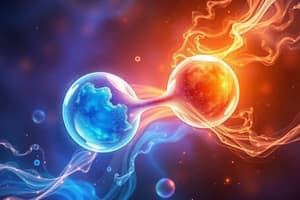Podcast
Questions and Answers
What is a double covalent bond?
What is a double covalent bond?
- A covalent bond where only one pair of electrons are shared
- A covalent bond where two pairs of electrons are shared (correct)
- A covalent bond where three pairs of electrons are shared
- A bond formed between ions
What are dipole interactions?
What are dipole interactions?
- Forces between non-polar molecules
- Forces between polar molecules (correct)
- Covalent forces holding atoms together
- Forces that occur between ions
What is the octet rule?
What is the octet rule?
Atoms have a tendency to bond in such a way as to obtain a noble gas configuration, usually having eight valence electrons.
What is a polar bond?
What is a polar bond?
What is a hydrogen bond?
What is a hydrogen bond?
What is a single covalent bond?
What is a single covalent bond?
How do atoms achieve noble-gas electron configurations in single covalent bonds?
How do atoms achieve noble-gas electron configurations in single covalent bonds?
Why do atoms share electrons in covalent bonds?
Why do atoms share electrons in covalent bonds?
Which element can form diatomic molecules held together by triple covalent bonds?
Which element can form diatomic molecules held together by triple covalent bonds?
Which noble gas has the same electron configuration as the oxygen in a water molecule?
Which noble gas has the same electron configuration as the oxygen in a water molecule?
Which elements can form diatomic molecules joined by a single covalent bond?
Which elements can form diatomic molecules joined by a single covalent bond?
What is the representative unit in a molecular compound?
What is the representative unit in a molecular compound?
Which diatomic molecule is joined by a double covalent bond?
Which diatomic molecule is joined by a double covalent bond?
What does the chemical formula of an ionic compound show?
What does the chemical formula of an ionic compound show?
How many valid electron dot formulas can be written when a resonance structure occurs?
How many valid electron dot formulas can be written when a resonance structure occurs?
Which atom acquires the most negative charge in a covalent bond with hydrogen?
Which atom acquires the most negative charge in a covalent bond with hydrogen?
A bond formed between a silicon (electronegativity = 1.8) atom and an oxygen (electronegativity = 3.5) atom is likely to be ____.
A bond formed between a silicon (electronegativity = 1.8) atom and an oxygen (electronegativity = 3.5) atom is likely to be ____.
Which of the following covalent bonds is the most polar?
Which of the following covalent bonds is the most polar?
What is thought to cause dispersion forces?
What is thought to cause dispersion forces?
Which of the forces of molecular attraction is the weakest?
Which of the forces of molecular attraction is the weakest?
What causes dipole interactions?
What causes dipole interactions?
What causes hydrogen bonding?
What causes hydrogen bonding?
Which type of solid has the highest melting point?
Which type of solid has the highest melting point?
What information does a molecular formula provide?
What information does a molecular formula provide?
What does the molecular formula HCN indicate about hydrogen cyanide?
What does the molecular formula HCN indicate about hydrogen cyanide?
What is shown by the structural formula of a molecule or polyatomic ion?
What is shown by the structural formula of a molecule or polyatomic ion?
Flashcards are hidden until you start studying
Study Notes
Chemical Bonds and Interactions
- Double Covalent Bond: Involves the sharing of two pairs of electrons between atoms.
- Single Covalent Bond: Involves sharing one pair of electrons.
- Polar Bond: Occurs between atoms with a significant difference in electronegativity (>0.4).
- Hydrogen Bond: A crucial interaction involving hydrogen in a polar bond attracted to unshared electrons in another molecule, influencing properties of water, proteins, and DNA.
Molecular Concepts
- Octet Rule: Atoms tend to bond to achieve a noble gas configuration, typically aiming for eight valence electrons.
- Molecular Formula: Indicates the types and quantities of atoms in a molecule, e.g., HCN denotes one hydrogen, one carbon, and one nitrogen atom.
- Representative Unit in Molecular Compounds: Identified as a molecule.
Forces of Attraction
- Dipole Interactions: Attractive forces between polar molecules.
- Dispersion Forces: Caused by electron motion, recognized as the weakest molecular attraction force.
- Covalent Network Solid: Type of solid exhibiting the highest melting points due to strong covalent bonds.
Electron Sharing and Stability
- Achieving Noble-Gas Configurations: Atoms achieve stability by sharing electrons in covalent bonds.
- Resonance Structures: A molecule can have two or more valid electron dot formulas, reflecting different configurations of electron pairs.
Bond Polarity
- Most Polar Covalent Bond: H—F, due to fluorine's high electronegativity (4.0).
- Polar Covalent Bond Example: Formed between silicon (1.8) and oxygen (3.5), indicating unequal sharing of electrons.
- Atom with Greatest Negative Charge in Bond: Oxygen (3.5) acquires more negative charge when covalently bonded to hydrogen (2.1).
Diatomic and Noble Gases
- Diatomic Molecules with Triple Covalent Bonds: Nitrogen can form these types of molecules.
- Diatomic Molecules with Single Covalent Bonds: Formed only by hydrogen and halogens.
- Noble Gas Configuration of Water: Neon has the same electron configuration as oxygen in water.
Structural and Arrangement Insights
- Structural Formula Significance: Shows how atoms are arranged and bonded within a molecule or polyatomic ion.
- Chemical Formula of Ionic Compounds: Reveals the lowest whole-number ratio of ions present.
Summary of Molecular Interactions
- Hydrogen Bonding: Arises from a covalently bonded hydrogen atom interacting with another molecule's unshared electron pair.
- Dipole Interaction Cause: Resulting from the attraction between polar molecules, leading to specific physical properties.
Studying That Suits You
Use AI to generate personalized quizzes and flashcards to suit your learning preferences.




